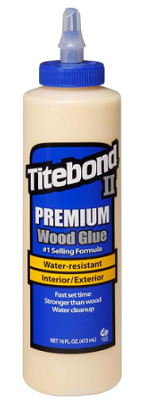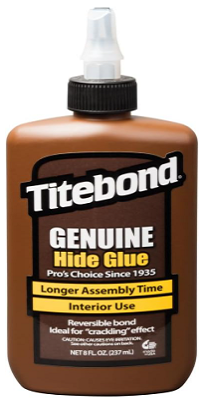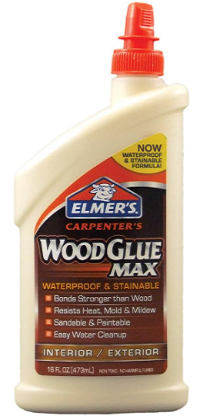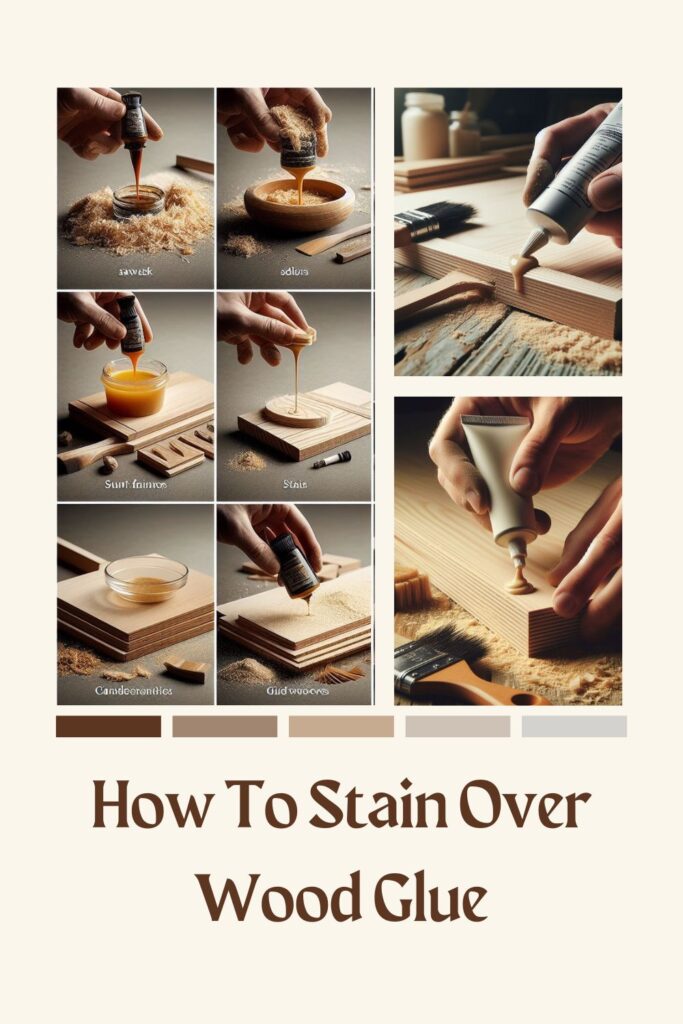Is Wood Glue And Sawdust Stainable : A Guide to DIY Woodworking

Is wood glue and sawdust stainable? Whether wood glue and sawdust are stainable depends on several factors:
1. Type of Glue:
- Aliphatic wood glue (white glue): Generally not stainable. It creates a film that repels stain, leaving a lighter patch.
- Polyvinyl acetate (PVA) glue: Similar to white glue, usually not stainable.
- Titebond II: Water-based, absorbs stain somewhat, but may not match the surrounding wood perfectly.
- Hide glue: Traditional glue, highly stainable, but harder to find and work with.
- Epoxy: Some types are partially stainable, but can be tricky and leave a noticeable difference.
2. Sawdust:
- Matching wood species: Using sawdust from the same wood you’re staining helps it blend in better, but it might still be slightly darker.
- Unmatched wood species: Can create a noticeable difference in color and absorption.
3. Staining Technique:
- Direct staining: May be difficult to achieve a uniform color due to the glue’s repellency.
- Pre-staining: Staining the wood before filling can help the filler absorb stain more evenly, but requires careful masking and sanding.
Overall, staining wood glue and sawdust is not impossible, but it can be challenging and may not always result in a perfect match. However, if you mix them together to form a putty. Then apply it to the surface of the wood, it’s possible to stain the resulting mixture.
Here are some additional points to consider:
- Always test any stain on a scrap piece of wood with the same glue and sawdust combination before staining the actual project.
- Consider using a wood filler specifically designed to be stainable.
- If a perfect color match is crucial, you might need to explore alternative repair methods like using colored putty or sanding and refinishing the entire piece.
Remember, testing on scrap wood is always recommended before applying any techniques to your actual project.
Can You Stain Wood Glue And Sawdust?
Yes, with some condition, you can stain wood glue and sawdust mixture. By mixing sawdust with wood glue and applying it to the surface of the wood, you can create a wood filler that can be stained to match the surrounding wood.
Wood Glue That Can Be Stained
There are specific wood glues available that are formulated to be stainable. Here are some options to consider:
1. Titebond Titebond II Premium Wood Glue
- This is a popular PVA glue that is known for its strong bond and sandability.
- It is also labeled as “stainable,” but it’s still recommended to test it on scrap wood first to ensure compatibility with your chosen stain.

2. Franklin Titebond Liquid Hide Glue
- This is a traditional hide glue that is naturally stainable.
- However, it requires more work to use than other glues, as it needs to be heated before application.

3. Elmer’s Wood Glue Max Review
Elmers is the best wood glue that can be stained. This 16-ounce bottle features a convenient squeeze bottle for easy application. Its PVA-based formula is formulated to be stronger than the wood itself, creating a permanent and reliable bond.

Features
- Waterproof: Resists moisture, making it suitable for outdoor use.
- Sands and Paintable: Can be sanded smooth and finished with paint or stain.
- Easy Cleanup: Cleans up easily with water.
- Non-Toxic: Safe for indoor use and around children and pets.
- Fast Setting: Provides a strong initial bond in 20-30 minutes, with full cure in 24 hours.
- Versatile: Bonds a variety of wood types, including hard and softwoods, plywood, and MDF.
Pros
- Strong bond: Offers superior strength compared to standard wood glue.
- Durable: Withstands moisture, heat, and cold for long-lasting results.
- Versatile: Suitable for various indoor and outdoor projects.
- Easy to use: Convenient squeeze bottle and water cleanup make it user-friendly.
- Affordable: Competitively priced compared to other high-strength wood glues.
Cons
- Requires separate filler for larger gaps or uneven surfaces.
- While advertised as stainable, testing on scrap wood is recommended.
Read More About Wood Glue FAQ
Can Elmers Wood Glue Be Stained?
It depends on which Elmer’s wood glue you’re using:
Regular Elmer’s Wood Glue (white glue) and PVA glues: No, they are not recommended for staining. These glues create a water-resistant barrier that repels stain, leading to an uneven and blotchy appearance.
Elmer’s Stainable Wood Glue Max: This specific glue claims to be stainable. It contains real wood fibers that help it take stain more evenly, but testing on scrap wood is still crucial to ensure compatibility with your chosen stain.
How Do You Use Elmer’s Wood Glue Max?
- Apply a thin, even layer of glue to one surface. You can use the squeeze bottle tip or a paintbrush/spreader for better control.
- Spread the glue evenly: Ensure good coverage without excessive buildup.
- Assemble the pieces: Join the glued surfaces immediately and press firmly together.
- Clamp (optional): For stronger bonds or larger joints, use clamps to apply pressure and maintain alignment during drying.
- Wipe away excess glue: Use a damp cloth to remove any squeezed-out glue before it dries.
- Follow the drying time recommendations: Typically, it’s 20-30 minutes for initial bond and 24 hours for full cure.
- Painting or staining: If desired, paint or stain the glued area after complete drying and sanding.
Can You Stain Wood Glue?
Regular wood glue (white glue) cannot be stained due to its water resistance. However, some “stainable” wood glues exist, but even those require testing for best results. Consider stainable wood putty or professional help for a flawless stained finish.
How Do You Make Wood Filler From Sawdust And Wood Glue?
Here’s how to do it: wood glue sawdust filler
1. Mix the filler
Start with a small amount of glue and gradually add sawdust, mixing well until you achieve a thick, putty-like consistency.
2. Apply the filler
Use a putty knife or applicator to fill the hole or gap. Press the filler firmly to ensure good adhesion and avoid air pockets.
3. Shape and smooth
While the filler is still slightly wet, use a damp cloth or your finger to smooth the surface and remove excess.
4. Let it dry
Refer to the glue’s drying time instructions (usually 20-30 minutes initially, 24 hours full cure).
5. Sanding
Once fully dry, use sandpaper (starting with coarse grit and moving to finer) to achieve a smooth and level finish. Be gentle to avoid sanding through the filler.
6. Repeat (optional)
If the filler shrinks or dips after drying, apply another thin layer, repeating steps 5-7.
7. Can You Mix Titebond With Sawdust?
Yes, you can mix Titebond wood glue with sawdust to create a homemade wood filler. Choose the appropriate Titebond glue (aliphatic for indoor, waterproof for outdoor) and fine sawdust from the same wood species.
How Do You Make Homemade Stainable Wood Filler?
For DIY efforts:
- Use fine sawdust from your project’s wood species.
- Mix with stainable wood glue (test on scrap!).
- Aim for a thick, putty-like consistency.
- Apply, shape, and let dry completely.
- Sanding and staining require careful testing for even color absorption.
What Can I Mix With Sawdust To Make Wood Filler?
While wood glue and same-species sawdust are common, for small repairs you can also mix sawdust with:
- Epoxy: Strong and waterproof, but darkens and may not stain evenly.
- Shellac: Thinner consistency, good for fine cracks, but not ideal for large gaps.
- PVA glue: Similar to wood glue, but test staining compatibility first.
Can Wood Glue Be Used As Wood Filler?
Technically use wood glue mixed with sawdust as a basic filler, it’s not ideal. Regular wood glue isn’t designed for filling and may not be very strong or durable. Consider dedicated wood filler for a better repair, especially for larger gaps or critical projects.
How To Make Wood Filler Without Sawdust
Here are some ways to make wood filler without sawdust:
- Cornstarch and wood glue: Mix equal parts cornstarch and wood glue for a paste-like filler. Works well for small indoor repairs.
- Baking soda and wood glue: Similar to cornstarch, mix baking soda and wood glue to create a lightweight filler.
- Ash from your fireplace: Grind fireplace ash (wood only) and mix with wood glue for a color-matched filler. Test for staining compatibility.
- Commercial alternatives: Consider readily available stainable wood putty or gap-filling compounds for more reliable results.
How To Make Stainable Wood Filler With Sawdust
Making stainable wood filler from sawdust requires specific glue choice:
- Choose stainable wood glue: Skip regular “white glue” – it repels stain. Opt for “stainable” PVA or polyurethane glue based on project needs (indoor/outdoor).
- Fine sawdust match: Use fine sawdust from the same wood species for best color match and stainability.
Wood Glue And Sawdust As Filler
Mixing sawdust with wood glue can create a DIY filler, but it has limitations:
- Not as strong or durable as store-bought options.
- Staining can be tricky due to uneven absorption.
- Best for small repairs, not deep gaps or critical projects.
Read Also Gorilla Wood Glue: Strong Bonding for Woodworking Projects
How To Stain Over Wood Glue
Staining over regular wood glue is risky due to uneven absorption, leading to blotchy results. However, consider these options:
- Test: Always test glue & stain on scrap wood first.
- Staining before gluing: Risky, requires precise work & sanding to avoid damaging stained surface.
- Staining after gluing: More common, but potential uneven color absorption might require additional sanding & restaining.
- Stainable wood putty: More reliable for seamless, stained finish.

Can Stained Wood Be Glued?
Yes, stained wood can sometimes be glued, but with limitations: Water-based and oil-based stains create barriers.
Will Super Glue Work On Stained Wood?
While super glue can technically bond stained wood, it’s not generally recommended. The glue can leave visible marks, cloud the stain, and potentially damage the finish. For stained wood repairs, opt for wood glue specifically designed for stained surfaces.
Can You Add Stain To Wood Glue?
Adding stain directly to wood glue isn’t recommended. Regular glue repels stain, leading to blotchy results. Some “stainable” glues exist, but even those require testing. For a flawless stained finish, consider stainable wood putty or professional help.
What Glue To Use On Stained Wood?
Regular wood glue won’t stain evenly on colored wood. Choose “stainable” wood glue (polyurethane or some PVAs) and test on scrap first.
Alternatives to staining wood glue and sawdust
- Pre-staining the wood.
- Using stainable filler.
- Applying colored putty or touch-up paint.
- Sanding and refinishing the entire piece for a uniform color.
Making wood glue and sawdust filler blend in
- Using sawdust from the same wood species helps, but may still not achieve a perfect match.
- Pre-staining or using stainable filler offers better blending potential.
Hiding wood glue and sawdust repairs with stain
This can be challenging due to absorption differences. Consider alternatives like pre-staining or specialized fillers.
DIY Furniture Repair with Wood Glue and Sawdust: Tips and Alternatives
While repairing furniture with wood glue and sawdust is a budget-friendly option, it comes with its own set of challenges, particularly when it comes to staining. Here’s what you need to know:
Pros:
- Cost-effective: Utilizes readily available materials.
- Strong bond: Wood glue creates a durable repair for small cracks and chips.
- Matches the wood grain: Using sawdust from the same wood ensures a natural-looking repair.
Cons:
- Staining challenges: Glue repels stain, and sawdust absorbs differently, potentially leaving a visible patch.
- Limited color control: Achieving a perfect color match can be difficult.
- Not suitable for large repairs: May not hold for extensive damage or structural issues.
Tips for Using Wood Glue and Sawdust:
- Clean and dry the area thoroughly.
- Mix fine sawdust with wood glue until it forms a thick paste. Use sawdust from the same wood type for better color matching.
- Apply the filler generously and press it firmly into the crack or chip. Overfill slightly to account for shrinkage.
- Allow the filler to dry completely according to the glue instructions.
- Sand the area smooth and level. Be careful not to sand through the filler
FAQs
Can Titebond glue be stained?
Most Titebond glues, like their original wood glue, are NOT stainable due to their water resistance. However, Titebond offers some “stainable” varieties like Titebond II Premium Wood Glue.
Can you stain Elmer’s wood glue?
Regular Elmer’s wood glue (white glue) cannot be stained due to its water resistance. However, Elmer’s offers “Stainable Wood Glue Max” specifically designed for taking stain. Even then, testing on scrap wood is crucial for best results.
Can I add color to wood glue?
Yes, but with limitations! Regular wood glue repels stain. Consider “stainable” wood glue or mixing colored sawdust with glue for small areas, but test on scrap wood first for evenness. For critical projects, pre-staining or professional help might be better.
How long after wood glue can you stain?
It depends! Most wood glues require a full cure before staining, which can take 24-48 hours.
Will stain go over wood glue?
Regular wood glue (white glue) repels stain, leaving an uneven blotchy finish. Some “stainable” glues exist, but results vary. Test first!
Is Titebond wood glue Stainable?
Most Titebond glues, including their classic white glue, are NOT stainable due to their water resistance.
How deep does wood glue penetrate?
Wood glue typically penetrates 2-6 cells deep into the wood, aiming for good surface contact and mechanical interlocking. Depth depends on wood type, glue choice, and moisture content.
Will wood glue work if the wood is stained?
Regular wood glue won’t adhere well to stained wood due to its water resistance. Consider stainable glues or alternative solutions like pre-staining or professional repairs.
Conclusion
So, is wood glue and sawdust stainable? wood glue and sawdust, in their most common forms, are not directly stainable. Regular white glue (aliphatic) and PVA glues create water-resistant barriers that repel stain, leading to blotchy results.
While some “stainable” wood glues exist, even those require careful testing and might not achieve a perfectly even stain.






